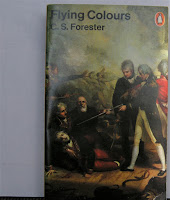In his Hornblower
stories C.S. Forester combines historical accuracy with exciting adventure. We
meet seventeen year old Horatio in the first book, Mr. Midshipman Hornblower,
when he is
commissioned to service as a midshipman in the Royal Navy. The date
is January, 1794, five years
after the start of the French Revolution.
Horatio is a quiet lad,
not really at ease in society, totally inexperienced and further burdened by a
nervous stutter. Like his famous namesake, Horatio Nelson, young Hornblower is
desperately seasick
at the start of every voyage. Added to Hornblower’s
inadequacies for adaption to life at sea is his fear
of heights, so it is
scarcely surprising he is given a really hard time by his fellow midshipmen who
consider him totally unfit for a life at sea.
 Though desperately unhappy, Hornblower carries out his duties faithfully and well. The worst of Horatio's bullies is Midshipman Simpson, a man in his thirties who has failed the Lieutenant's exam so many times he knows he will never get promotion. Simpson finally goads Hornblower into challenging him to a duel with pistols. The ship's captain is informed of this and, by now well aware of Hornblower's potential, steps in to ensure neither pistol is loaded. Later the captain arranges for Hornblower's transfer to another ship, HMS Indefatigable. Aboard Indefatigable Hornblower is plunged into war with the French. He is given charge of a captured brig, loses it, tangles with Spaniards, is confined to a Spanish prison, and finally released.
Though desperately unhappy, Hornblower carries out his duties faithfully and well. The worst of Horatio's bullies is Midshipman Simpson, a man in his thirties who has failed the Lieutenant's exam so many times he knows he will never get promotion. Simpson finally goads Hornblower into challenging him to a duel with pistols. The ship's captain is informed of this and, by now well aware of Hornblower's potential, steps in to ensure neither pistol is loaded. Later the captain arranges for Hornblower's transfer to another ship, HMS Indefatigable. Aboard Indefatigable Hornblower is plunged into war with the French. He is given charge of a captured brig, loses it, tangles with Spaniards, is confined to a Spanish prison, and finally released.
Arrived back in England, Hornblower achieves the rank of Lieutenant.
In The Happy Return (entitled Beat to Quarters in the U.S.A.), he is now a
Captain, under orders to
sail his frigate, HMS Lydia, into South American
waters to track down, pursue and sink the Spanish
two-decker Natividad, a ship
with nearly twice as much firepower as the Lydia.
Having successfully completed his mission to
sink the Natividad, Hornblower sets out in quest of
further victories.
Alas, in A Ship of the
Line, Hornblower meets with ignominious defeat and the
humiliation of yielding
his ship to the French. He himself is taken prisoner.
From the confines of the French prison, and with his own execution imminent, Hornblower
witnesses firsthand the horrors of the guillotine. Eventually he escapes from Napoleon's marinets
as he is being taken to face a firing squad.
With many adventures along the road, Hornblower makes his way down the Loire and to freedom in
Flying Colours.
Hornblower and the Crisis brings our Hero to the Battle of Trafalgar and, in fierce hand-to-hand
fighting, the most desperate battle of his life.
Following the death of Lord Nelson at Trafalgar, Horatio leaves a nation in mourning and returns to
the fray against Bonaparte's navy in Hornblower and the Atropos.
To conclude this blog, when asked what he thought of the Hornblower books, a youthful reader enthused, "Oh, they're incomparable. Terrific writing. C.S. Forester is fantastically knowledgeable but never tedious on technical things. You get such a feel for the period. The lifestyles, politics, attitudes, day to day living, all that sort of thing. And with gripping stories underpinning it all."
What greater praise could be given the series, what greater hook to entice young readers to historical fiction?





No comments:
Post a Comment